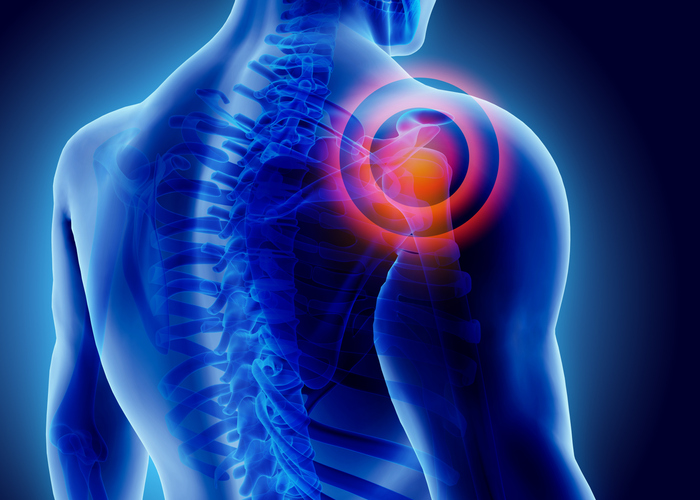6 Ways I Improved My Joint Health and Became Pain Free
3 years ago | Joints
After 30 years of playing golf, I developed some pain in my left shoulder. To be honest, the pain was pretty annoying with a burning sensation. I suspected a heart problem with the shoulder pain because heart disease runs in my family. But after having an MRI, I discovered I had mild osteoarthritis (often called “wear-and-tear”), mild tendinosis (makes sense because one of the symptoms is burning) and mild bursitis.
Did you know that “arthritis” literally means joint inflammation?
“Although joint inflammation is a symptom or sign rather than a specific diagnosis, the term arthritis is often used to refer to any disorder that affects the joints. Joints are places where two bones meet, such as your elbow or knee,” according to the National Institute of Arthritis and Musculoskeletal and Skin Diseases.
The shoulder, which as I mentioned is where I am experiencing my issues, has four joints.
I am usually proactive about my health, but to be honest, I totally forgot to put a special emphasis on my joint health as I age. Just exercising and taking my routine supplements such as vitamins C and D and magnesium are really not enough when it comes to keeping my joints in top shape. Routine wear and tear and repeated use of the joints may cause discomfort if we are not more proactive.

Many of my friends and fellow golfers also have joint pains and limitations. Reportedly, more than 54 million adults in the United States have some kind of arthritis. Furthermore, for almost half of this group the pain from the arthritis is so bad that it makes daily life harder.
It appears that as we age friction develops in our joints, especially if you are like me and lead an active lifestyle. It is also true that as we age our cartilage becomes thinner.
“Cartilage is a firm, rubbery, flexible connective tissue covering the ends of bones in normal joints. It is primarily made up of water and proteins whose primary function is to reduce friction in the joints and serve as a ‘shock absorber,’” according to the Cleveland Clinic.
“The shock-absorbing quality of normal cartilage comes from its ability to change shape when compressed, because of its high water content. Although cartilage may undergo some repair when damaged, the body does not grow new cartilage after injury. Cartilage is avascular, meaning there are no blood vessels in it. Therefore, healing is a slow process.”
And although being overweight or obese does make a person even more prone to joint issues due to the added stress and inflammation excessive weight puts on the joints, you can be a lean and athletic person and still have problems. Just frequent use of joints, especially through high impact exercises such as running, can increase joint degeneration and increased joint discomfort.
Being sedentary is not the answer.I am by no means telling people to lead a sedentary lifestyle in order to avoid wear and tear on the joints, but we must be extremely proactive if we want to lead quality lives with as little pain as possible.
Many people turn to nonsteroidal anti-inflammatory drugs (NSAIDs) and cortisone shots to relieve pain, but these do not address the root of the problem. The relief they provide is also temporary.
I experienced true, long-lasting pain relief after fully committing to paying more attention to my joints. Below is what I did. No, I did not rest for a long time. That would drive me nuts, because I love being on the move and playing golf. I rested my shoulder for four days, and incorporated a joint routine. I did the following:
- Increased my magnesium intake to 600 mg.
The recommended dietary allowance (RDA) for magnesium is 320 mg daily for women and 420 mg daily for men, give or take. My nutrient test showed that my magnesium level was borderline. With the guidance of my doctor, I increased my daily intake to 600 mg.
Magnesium is an essential mineral which helps to strengthen bones and performs a role in maintaining nerve and muscle function. Magnesium supplements are anti-inflammatories which are helpful to address symptoms of arthritis as well as improve joint health. Apparently, one way this is achieved is by moving blood sugar quickly into the muscles and reducing the C-reactive protein (CRP) marker in the body which causes inflammation.
It is an important cofactor for hundreds of processes and reactions in the body and has antinociceptive effects, meaning it can keep the nociceptor (a sensory receptor for pain) from overreacting when it talks to your brain about the pain you are experiencing. In a study of hip replacement patients, magnesium plus morphine was more effective for pain than morphine used alone.
Furthermore, another study found evidence suggesting that magnesium helps with reducing chondrocyte apoptosis (cell death). Chondrocytes are types of cells that make up cartilage.
Note that there are many different forms of magnesium including those that will cause diarrhea. It is important to take the correct form of this supplement to reap the benefits.
- Started taking Designs For Health’s TRF 150 supplement.
This particular supplement is high quality and was recommended by my doctor. It contains a bone-derived protein/collagen complex called Cyplexinol. As we age, natural collagen production slows down. There is evidence that Cyplexinol plays a huge role in achieving optimal bone and joint health.
"In particular, scientific research demonstrates that this supplement provides benefits to the joints in as little as seven days; that this osteoinductive BMP-complex promotes the regeneration of joint and bone tissue; that it helps supports a healthy bone density, and that it encourages a healthy inflammatory response."
“Collagen proteins are helpful for a number of issues. Because of its primary structural role in certain tissues, collagen has been shown to help increase bone mineral density, support healthy blood pressure, improve nail growth and the appearance of skin wrinkles, and reduce some of the symptoms associated with osteoarthritis [which is what I was battling],” reports Designs for Health.
- Committed to regular sessions of red light therapy.
Red light therapy (RLT) is a form of low-level laser (light) therapy (LLLT) and is offered in many medical office settings. Think of it as like a healthy tanning bed. During a session, the light delivers wavelengths of natural red and near infrared light. It’s like the wavelengths you get from sunlight without the harmful UV rays.
Treatment with RLT is reported to reduce inflammation, joint pain and arthritis. It may even stimulate collagen production and increase blood circulation (both very important for joint health).
- Treated myself to hot and cold massages (cryo thermal massages).
Two popular pain relieving therapies are cryotherapy (cold therapy) and thermography (heat therapy). When people experience pain, they often go straight to cold therapy and do not realize that a combination of both cold and hot can be highly effective.
Cold therapy promotes vasoconstriction or constriction of the blood vessels. When the blood vessels constrict, blood circulation is slowed which in turn reduces redness, swelling, spasms and pain. The cold temperature may numb sharp pain. It can even reduce nerve activity, which may also provide some pain relief.
Unlike cold therapy, heat therapy increases the flow of blood and nutrients to various areas of the body. Heat is sometimes used to alleviate muscle stiffness and pain. It is also reported to be great for chronic low back pain as well as chronic pain in general. Hot temperatures widen blood vessels, which usually promotes circulation. This increased circulation, in turn, will usually provide the nutrients the body needs to recover and reduce pain.
Combine both of these therapies with massage, and you really have a great tool for fighting joint pain. Massage improves circulation and blood flow and may help reduce the root cause of pain - inflammation.
(You might also want to consider lymphatic drainage massage).
- Underwent full body cryotherapy (twice a week).
Standing in a cryogenic chamber for three minutes is not for the faint of heart, but trust me when I say it is so worth it! I just focused on getting rid of the inflammation so I could get on with my daily activities.
Whole body cryotherapy may speed up injury recovery, relieve pain and soreness, reduce lactic acids, reduce inflammation, decrease spasms, release endorphins, improve range of motion and so much more!
- Resumed my normal physical activities.
It may sound counterproductive because physical activity does eventually lead to some wear and tear, however, staying active is actually crucial for joint health.
“Keeping active is actually very good for individuals suffering from joint pain or arthritis. Exercises that work the muscles and tendons provide stability and strength around the joint,” said Dr. Craig Israelite, orthopaedic surgeon and Co-director of the Knee Service at Penn Medicine. Furthermore, “Exercise increases blood flow to cartilage, bringing it the nutrients it needs to stay healthy,” (American Academy of Orthopaedic Surgeons).
So there you have it! My proactive care plan for managing my joint issues. I want to emphasize that in addition to educating yourself, it’s always good to consult a competent healthcare professional when it comes to taking supplements and starting treatments that are unfamiliar to you, especially if you have existing health issues or are pregnant or breastfeeding.
Enjoy your healthy life!
Disclaimer: This article is not intended to provide medical advice. Please consult with your doctor or another competent healthcare practitioner to get specific medical advice for your situation.
The pH professional health care team includes recognized experts from a variety of health care and related disciplines, including physicians, attorneys, nutritionists, nurses, and certified fitness instructors. This team also includes the members of the pH Medical Advisory Board, which constantly monitors all pH programs, products, and services. To learn more about the pH Medical Advisory Board, click here.







